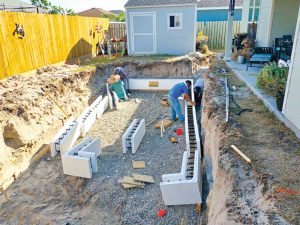
A Growing Trend for Building Pools
By Matthew Sands
Pool builders are currently integrating insulated concrete forms (ICF) methodologies into pool construction, specifically incorporating polyvinyl chloride (PVC) membrane interiors.
When it comes to construction techniques for building pools, the industry is always exploring new options to meet the needs of the market. Suppliers frequently introduce new product innovations that enhance pool esthetics or technologies from parallel industries that are incorporated into pool construction to either overcome market obstacles or meet consumer demands.
It therefore comes as no surprise there is a growing number of pool builders turning to insulated concrete forms (ICFs) with a polyvinyl chloride (PVC) membrane interior to create a solid concrete pool wall structure with a durable and attractive waterproofing solution that is welded onsite. Since these construction materials (foam forms and PVC membrane) are stocked and readily available, it enables builders to construct pools quickly and easily for any size yard with resort-style features that are in high demand.
The ICF system is newer to the pool industry but has been used in home building for many years. What has really helped boost the success of the system is the availability of new durable, attractive, and readily available PVC waterproofing membrane that has been a standard in Europe for decades. As a result, pool builders are currently integrating ICF methodologies into pool construction, specifically incorporating PVC membrane interiors. This integration facilitates the creation of custom pools while concurrently granting builders increased control over their construction timelines.

Understanding ICFs
ICFs comprise hollow blocks composed of expanded polystyrene foam and plastic bridges, or webbing, which serve the purpose of connecting the block sides. ICF systems have a long history of application in residential construction, particularly in the context of home foundations. This building technique relies on interlocking expanded polystyrene (EPS) foam blocks to establish a framework for reinforced concrete walls. These ICFs are systematically stacked atop each other and fortified with steel rebar. Subsequently, concrete is introduced into these forms, thereby generating a robust and enduring pool structure. Following the curing of the concrete, the forms persist in their placement, delivering superior insulation properties for the pool.






